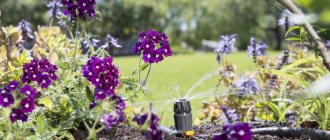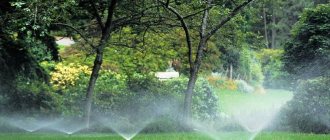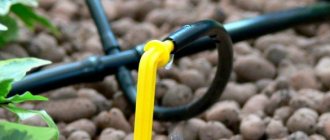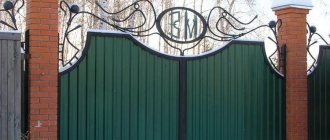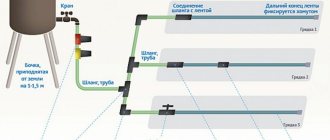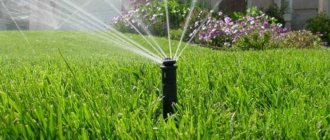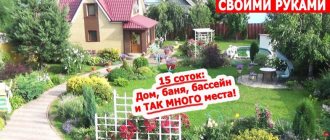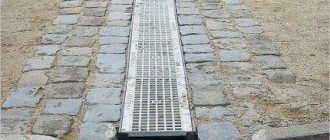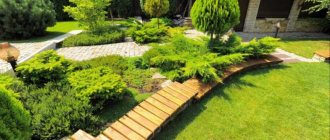A shiny sprinkler over the lawn rose and the stream rushed off. It’s scary to think how I blindly trust Automatic Watering
We live in interesting times. A time when various amazing iron, plastic and electronic assistants enter our apartment, garden and vegetable garden straight from the pages of science fiction novels of the end of the last century. Automatic watering systems can also be considered such assistants. They have long been used in a professional environment, but some time ago they became available to owners of individual plots and even potted winter gardens. As the name suggests, these are systems that automatically irrigate plants. At the same time, both the methods of managing these systems and the types of irrigation may be different.
Types of irrigation systems
Plants can be included in the automatic watering structure if they are planted on a windowsill, on the ground or in a greenhouse.
Sprinklers. Water is sprayed over the soil, simulating rain, and is often used for lawns. Often such spraying is excessively abundant for some plant species.
Drip root irrigation. With this method of watering, water is supplied directly to the root of the plant in drops or small streams of water.
This method of watering is often used for vegetable or berry crops in the garden and greenhouse; a smaller version of this watering can be used on the windowsill.
Underground water application. This type of irrigation is very similar to the previous one, the difference is that in this case hoses made of more durable material are used.
Construction principles
The concept of automatic watering is briefly as follows. There is a water source, from which a main pipeline is routed across the site to the irrigation zones. Next, using tees, crosses, small-diameter pipes and water supply devices, an irrigation system is created. For normal operation of water outlet units, filters are required; they are installed on the main water supply. That's all. Everything else is specific. There may even be a pump or a control system, or you can do without them
Do-it-yourself automatic watering system is a real task
Read here how to organize water supply to your home from a well or borehole.
How to control
Irrigation can be controlled by a controller (automation unit) or a person by turning the tap. If a controller is installed, the system is almost completely automated: it turns the water supply on and off at a given time. There are devices with a very high degree of automation - they monitor the weather, soil moisture and adjust the operation of the equipment in accordance with this data. In the simplest version, automatic irrigation supplies water at a specified time and turns it off after a certain period of time (set in the settings).
If there is no irrigation controller, a person needs to open the water supply and stop it. But that’s all that’s required of you; the irrigation system will do the rest.
Water consumption and irrigation intensity
Since the flow of water through distribution points is generally normalized, it is possible to determine with fairly high accuracy how long watering should last so that there is not too much water and not too little. If all watered plants require the same amount of water, no difficulties arise, but this does not always happen. This is the case with a lawn; sometimes there are extensive plantings of identical plantings in a vegetable garden or garden. But a more common situation occurs when some plants are more moisture-loving, others less so. There are several ways to solve this problem:
- Install drippers or sprinklers with adjustable water flow. With their help, for each area or plant, set the required amount of moisture in one watering.
- Use multi-zone controllers. They can independently control multiple watering zones. This is convenient in the garden, garden or greenhouse, where there are extensive plantings of plants that require different moisture levels.
Sometimes it is more profitable to make two autonomous irrigation systems
- Make several independent systems. Sometimes this is more profitable than stretching a long pipeline from one section to another or purchasing complex controls.
That’s why you can do automatic watering yourself: you have a lot of opportunities to achieve the desired result.
Where to get water from
The source of water for an automatic irrigation system can be a water supply system, a container with pumped water, a well, a well, a river, or a lake. In all cases, filters are installed on the main pipeline. It's just that different sources require different equipment. If you pump water from an open source (river, lake), be sure to install a coarse filter first, then a fine filter. In all others (except for drinking water supply) only equipment for fine cleaning is installed.
Watering the area with your own hands can be done from any water source.
If we are talking about automatic watering of a garden or greenhouse, then it is definitely better to first pump the water into a container where it will heat up, and then distribute it throughout the area. For dachas and garden plots there are a number of systems that work almost by gravity. They need minimal pressure, which is created by raising the container to a height of about 1-2 meters. There are systems that can work if the container is raised 10-40 cm above the ground.
With such an organization - with a water container - you can choose any pump for an automatic irrigation system. If only he could periodically pump water into the tank. The water level in the container is most often controlled by a float mechanism (like the one in a toilet tank). In this case, do not forget to provide for an emergency overflow and take it to some source, otherwise your area may turn into a swamp.
If a water supply is used as a source - centralized or not, and drip irrigation is selected, a reducer is needed to reduce and stabilize the pressure in the system, since most of this equipment can operate at a pressure of no higher than 2 atm.
Devices and equipment
The main equipment used in irrigation designs is the same:
- pump;
- filter;
- reservoir for regulating water temperature;
- gearbox;
- main pipeline;
- local pipeline.
The undoubted difference is how the water is supplied: in the form of drizzling rain or directly to the root of the plant.
General rules
To effectively water the garden using any of these methods, you must follow a number of general rules:
- to determine the need for moisture, dig up a little soil at a depth of 30 cm and squeeze it in the palm of your hand - as long as it sticks together into a lump, watering is not required, as soon as it begins to crumble, it is necessary to water;
- in any case, the upper soil horizon should not be allowed to dry out completely;
- moistening should be infrequent and not too abundant, since when the surface layer in the soil becomes waterlogged, air exchange processes are disrupted;
- the optimal depth of soil moisture in the root zone for trees is 0.8–1 m, for shrubs – 0.5–0.6 m;
- you should not over-flood the area near the trunk, since the large lignified roots growing here do not have absorbing ability;
- water must be supplied to the projection area of the crown perimeter and beyond, where small roots are located (the more fertile the soil, the closer to the trunk the absorbent roots are located);
- In order for the soil to be as water-absorbing as possible, it must be dug up regularly, otherwise a certain amount of water will not be absorbed, but will remain on the surface and evaporate;
- Each time after complete absorption of moisture, the surface must also be loosened to avoid the formation of a crust.
Air humidity should also be taken into account. In dry, hot weather, moisturizing is required more often than in damp and foggy weather.
Related article:
Summer fertilizing for your garden: options and technologies
How to water your dacha yourself
Regular watering ensures that the crop is saturated with moisture, regardless of whether you monitor this system or not; in rainy weather, the equipment adapts and stops automatic watering. Therefore, when you come to relax at your dacha, at any time you will receive flowering and healthy plants in your dacha.
You can control the watering of plants via your smartphone, defining the spraying of water at different times, up to a year. This system is capable of comparative savings in electricity and water, which saves not only your own energy.
Along with watering, you can fertilize the plants, which means making your work and your loved ones much easier. For proper operation of this structure, it is only necessary to occasionally check its serviceability and prepare it for winter accordingly.
Accessories
Pipeline routing along the site is made of polymer pipes. They are resistant to corrosion, do not react to most fertilizers, are reliable, and easy to install (there are installation methods without any special devices). The most commonly used pipes are HDPE (low-density polyethylene). In addition to all the previously described advantages, they are also ultraviolet resistant: they can be laid over a surface. LDPE (high-density polyethylene), PVC (polyvinyl chloride, but it is afraid of ultraviolet radiation) and PPR (polypropylene, its disadvantage is that it must be joined by welding and cannot be disassembled) are also suitable.
Most often, do-it-yourself automatic irrigation systems are assembled from HDPE pipes with compression fittings
For automatic irrigation systems in dachas, greenhouses and vegetable gardens, a pipe of 32 mm in diameter is usually used. If you are going to water a large number of beds, it is better to take a size one step larger - up to 40 mm.
HDPE pipes are assembled using compression fittings (with threaded gaskets). They can withstand the pressure in the water supply systems of high-rise buildings, so they can withstand the pressure for irrigation accurately. Their advantage: at the end of the season they can be untwisted, everything dismantled, and used again next year.
If drip irrigation is selected, drip hoses or tapes can be connected to the main line; droppers can be mounted on ordinary hoses (they make a hole and insert a small device into it). When irrigating by sprinkling, sprinklers are installed. They have different structures and cover areas of different shapes and sizes - round, sector, rectangular.
The types and types of components for automatic irrigation are well described in a video from one of the leaders in the irrigation systems market, the German company Gardena. Their equipment is high-quality, but their prices are very high.
Determining the amount of water flowing through an irrigation system
Now you need to find out what is the maximum number of simultaneously operating sprinklers on your site. This also determines the operation of the irrigation canals in the system: whether they can function simultaneously or whether they will need to be launched one after another.
In order to find out the throughput, you will need a hose 1 m long and 19 mm in diameter. You need to record in seconds how long it takes for this hose to fill a ten-liter bucket of water. After this, we calculate the distance directly from the tap itself to the distant sprinkler so that after 15 meters we add another 2 seconds to the total time.
All obtained values must be added together and compared with the table included with the irrigation systems. This way you can determine the permissible number of sprinklers.
Which is better to buy automatic watering for greenhouses: review of popular kits
Those who do not want to independently select elements for an irrigation system can buy ready-made automatic watering. One of the most popular options for drip irrigation is the Aquadusya system. It is designed for an area of up to 5 m². The maximum watering time is 1 hour.
Automatic watering systems have sensors that measure humidity and therefore turn off when it rains
The kit includes hoses, drippers and a controller that runs on regular batteries. Using Aquadusi you can organize watering for 50 plants. The system is easy to use and can be installed independently, without the involvement of specialists, which is carried out on the basis of detailed instructions included with the product. The service life of the automatic watering system is at least 5 years. You can purchase the system for 5,400 rubles.
Another popular model of automatic watering for greenhouses, which can be purchased for 6,500 rubles, is the “Beetle” kit. The name of the root drip system comes from the appearance of the hose arrangement, which resembles an insect. The model is characterized by a simple design that can be assembled even by a novice master. The system is designed to water 60 plants on an area of 18 m². But there is also a greenhouse option, designed for 30 plants on an area of 6 m².
Helpful advice! The system can be expanded by additionally purchasing irrigation lines at the store.
Installation and connection of a drip irrigation system from a Zhuk tank
Automatic watering "Zhuk" consists of main pipelines and small branches, located in pairs opposite each other, at the ends of which there are sinusoidal droppers, which prevents their clogging. The kit may not include a timer, which requires additional purchase of the device. The system is equipped with a filter that automatically purifies water from mechanical impurities. Automatic watering is connected to a tap of the centralized water supply network or to a water meter barrel, which is usually located at a height of up to 4 m. Watering can last up to 2 hours with an interval of 1 to 160 hours.
Equipment selection
You need to find and choose the right equipment; as a rule, the size of the equipment varies depending on the size of the site itself.
- plastic pipes;
- connectors;
- sprinklers;
- drip hoses;
- automatic valves;
- pump;
- water tank;
- rain or soil moisture sensors;
- programmable controller.
